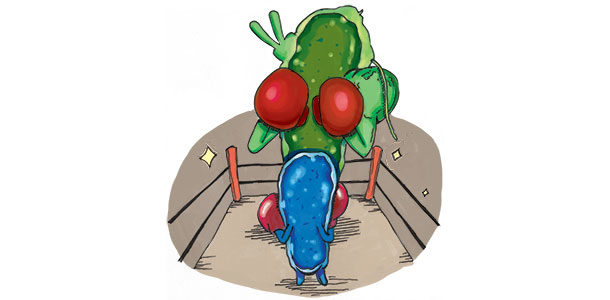Why didn’t it ferment? This question arises more often than you may think. Having reviewed and shared the results of several thousand forage samples in the past few years, when the fermentation profile does not conform to the dairyman’s expectation, invariably the question is asked, “Why didn’t it ferment?”
The countless potential answers become secondary to the obvious answer, “It did ferment, just not the way we would have liked.”
Fermentation, as in the preservation of an agricultural crop harvested one or a few times a year for storage and subsequent feeding, is the conversion of sugars to acids, gases and alcohols in the absence of oxygen (anaerobic environment).
While there are several potential end products that could be produced, fermentation of corn for corn silage or alfalfa for alfalfa haylage should be driven by lactic-acid-producing bacteria (LAB) with desirable end products of lactic acid, and to a lesser extent, acetic acid.
The key to fermentation is the conversion of sugars to lactic acid by LAB. So when we get those sample reports back from the lab, and the numbers don’t conform to our expectations, we have to ask the question “why” in hindsight. There are four main reasons why our crops might not have fermented properly:
1. Lack of water-soluble carbohydrates
As previously defined, fermentation requires sugars as a metabolic substrate for bacteria and are almost always glucose, fructose or sucrose. Generally, there are sufficient water-soluble carbohydrates liberated during chopping to ensure adequate fermentation; however, this is not always the case.
In the case of a rain event or even heavy dew, water-soluble carbohydrates may be washed away from the forage to be ensiled and may limit LAB activity.
2. Lack of bacterial activity
Plants in the field and those crops typically harvested for ensiling each have a significant population of naturally occurring microflora such as LAB, enterobacteria, yeasts, molds, clostridia and bacilli, to name a few, that are known as epiphytic micro-organisms.
These epiphytic micro-organisms produce a variety of metabolic end products, some of which are detrimental to ideal fermentation of the crop in the silo. If the numbers or proportions of undesirable organisms are sufficient to “out-compete” the desirable organisms, fermentation will yield undesirable end products.
In one instance, we were faced with 250,000,000 colony-forming units per gram of fresh-chopped whole-plant corn to be ensiled due to more than 12 years of corn-over-corn production using gray-water irrigation. This was a classic instance where we knew the undesirable organisms had a decided advantage over the desirable organisms at the outset.
There are other instances where the undesirable organisms may have an advantage during fermentation.
First, we chose not to apply a research-proven inoculant. Why wouldn’t we spend about $1 per ton of forage to shift the odds of a favorable fermentation in our favor? Given the value of fermented forage to the long-term success and profitability of the dairy, it seems foolish not to consider seriously the return on investment of a quality silage inoculant.
Second, we mixed the inoculant per the manufacturer’s label instructions and put it in the applicator, but it didn’t get applied. Why would we spend the money and the time to go through this process and not check to make certain that the equipment was functioning properly and applying the inoculant at the recommended rate?
A few minutes of time spent ensuring that the applicator is functioning properly can mean the difference between average forage and good forage you will feed for the next year.
Third, we applied the inoculant, but it didn’t work. Were the inoculant LAB alive when applied? We know that temperatures approaching 100°F kill inoculant LAB. Dead inoculant LAB will not ferment forage, no matter how many you apply.
Also, we know that applying inoculant LAB in extremely cold temperatures without adding propylene glycol will reduce the growth and metabolic activity of the inoculant LAB and the resulting efficiency of fermentation.
3. Buffering
We have taken care of No. 1 and No. 2, and ensured that everything is moving toward a favorable outcome. Even so, there are times when we can anticipate a challenging fermentation and need to plan accordingly – such is the case for alfalfa.
The reason alfalfa presents challenges to fermentation is multifaceted but hinges on buffering capacity. Alfalfa is high in protein, calcium and other minerals, and low in water-soluble carbohydrates. Protein and minerals serve to buffer the crop to be ensiled from reaching extremely low pH in light of potentially high lactic acid levels.
4. It did ferment …
Even when we focus our attention on the items above to improve the likelihood of a favorable fermentation, the results may be unfavorable. Whether it is enterobacteria, yeasts, molds, clostridia or bacilli, sometimes we just don’t win the battle.
Maybe we harvested the crop at a suboptimal maturity or moisture (too high or too low). Maybe we didn’t have sufficient packing tractor weight to achieve a minimum dry matter density of 18 pounds per cubic foot in order to minimize exposure to oxygen.
Maybe our forage sample is not representative of the vast majority of the forage in the pile or bunker. Regardless of what might have happened, we can still use this information to change our management practices for next year.
Unfortunately, when asked, “Why didn’t it ferment?” our response is usually, “It did ferment … just not the way we would have liked.” PD
Illustration
Desirable organisms must “out-compete” undesirable organisms for proper fermentation to occur. Illustration by Corey Lewis.

Keith A. Bryan
Technical Services Manager
CHR Hansen Animal Health and Nutrition







